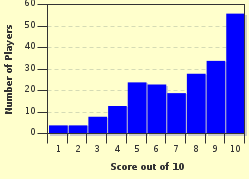Quiz Answer Key and Fun Facts
1. The Franks settled in the area that the Romans called Gaul. Which of these modern day countries was NOT part of Gaul?
2. Clovis, the founder of the Merovingian Dynasty, claimed descent from a legendary warrior who went by what name?
3. Clovis married Clothilde, who insisted that he convert to which religion?
4. Charles Martel is considered to be the founder of the Carolingian dynasty. What was the highest office he held?
5. Charles Martel saved Europe from further Muslim invasion at what battle in 732?
6. Many medieval monarchs had descriptors following their names. What was Pepin called?
7. What does Charlemagne's name mean?
8. Charlemagne was illiterate in today's sense of the word.
9. Where was Charlemagne's capital?
10. Who succeeded Charlemagne as king of the Franks?
Source: Author
ponycargirl
This quiz was reviewed by FunTrivia editor
Snowman before going online.
Any errors found in FunTrivia content are routinely corrected through our feedback system.

